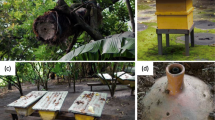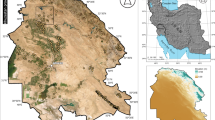Abstract
Vine vigour assessment has been a major concern of precision viticulture studies in order to identify areas of uniform vine performance within vineyards. Moreover, the counting and weighing of winter dormant canes is considered as the most informative measurement to indicate vine balance and is commonly performed manually by grape growers for management purposes. The main concern of this measurement is that it is time consuming and laborious and it cannot accommodate detailed sampling density. In the present study, the potential of using laser scanner technology as an automated, easy and rapid way to perform mapping of the winter pruning wood across the vineyard was investigated. The study was conducted during 2010 and 2011, in a one hectare commercial vineyard in central Greece, planted with cv. Agiorgitiko, a traditional Greek variety for the production of red wine. Parameters of topography, soil depth, soil texture, canopy properties (NDVI), yield, and grape quality were mapped and analysed in conjunction to winter canes weighing at pruning time. The mapping of the dormant canes was carried out using a 2D laser scanner sensor prior to pruning and manually measuring the pruning weight on a 10 × 20 m grid. Laser scanner measurements showed significant relationship in both 2010 and 2011 with pruning weight (r = 0.809 and r = 0.829 respectively, p < 0.001), yield and early season NDVI, showing the potential of using laser scanner measurements to assess variability in vine vigour within vineyards. These results suggest that laser scanners offer great promise to characterize within field variability in vine performance.




Similar content being viewed by others
References
Acevedo-Opazo, C., Tisseyre, B., Guillaume, S., & Ojeda, H. (2008). The potential of high spatial resolution information to define within-vineyard zones related to vine water status. Precision Agriculture, 9, 285–302.
Arno, J., Escola, A., & Rosell-Polo, J. R. (2017). Setting the optimal length to be scanned in rows of vines by using mobile terrestrial laser scanners. Precision Agriculture, 18(2), 145–151.
Bramley, R. G. V. (2005). Understanding variability in winegrape production systems. 2. Within vineyard variation in quality over several vintages. Australian Journal of Grape and Wine Research, 11, 33–42.
Bramley, R. G. V., & Hamilton, R. P. (2005). Hitting the zone—making viticulture more precise. In: R. J. Blair, P. J. Williams & I. S. Pretorius (Eds.), Proceedings of the 12th Australian Wine Industry Technical Conference (pp. 57–61). Winetitles, Adelaide SA.
Bramley, R., & Hamilton, R. (2007). Terroir and precision viticulture: Are they compatible? International Journal of Vine and Wine Sciences, 41(1), 1–8.
Bramley, R. G. V., Trought, M. C. T., & Praat, J. P. (2011). Vineyard variability in Marlborough, New Zeland: Characterizing variation. Australian Journal of Grape and Wine Research, 17, 72–78.
Ehlert, D., Heisig, M., & Adamek, R. (2010). Suitability of a laser rangefinder to characterize winter wheat. Precision Agriculture, 11(6), 650–663.
Ehsani, R., & Lang, L. (2002). A sensor for rapid estimation of plant biomass. In P. Robert (Ed.), Proceedings of the 6th international conference on precision agriculture. ASA/CSSA/SSSA, Madison, WI, USA.
Gil, E., Escola, A., Rosell, J. R., Planas, S., & Val, L. (2007). Variable-rate application of plant protection products in vineyard using ultrasonic sensors. Crop Protection, 26(8), 1287–1297.
Grocholsky, B., Nuske, S., Aasted, M., Achar, S., & Bates, T. (2011). A camera and laser system for automatic vine balance assessment. Transactions of the ASABE, 7, 5530–5544.
Hall, A., Lamb, D. W., Holzapfel, B. P., & Louis, J. P. (2011). Within-season temporal variation in correlations between vineyard canopy and winegrape composition and yield. Precision Agriculture, 12, 103–117.
Hansen, P. M., & Schjoerring, J. K. (2003). Reflectance measurement of canopy biomass and nitrogen status in wheat crops using normalized difference vegetation indices and partial least squares regression. Remote sensing Environment, 86, 542–553.
Johnson, L. F., Roczen, D. E., Youkhana, S. K., Nemani, R. R., & Bosch, D. F. (2003). Mapping vineyard leaf area with multispectral satellite imagery. Computers and Electronics in Agriculture, 38, 33–44.
Keightleya, K. E., & Bawden, G. W. (2010). 3D volumetric modeling of grapevine biomass using Tripod LiDAR. Computers and Electronics in Agriculture, 74, 305–312.
Lamb, D. W., Weedon, M. M., & Bramley, R. G. V. (2004). Using remote sensing to predict phenolics and color at harvest in a Cabernet Sauvignon vineyard: Timing observations against vine phenology and optimizing image resolution. Australian Journal of Grape and Wine Research, 10, 46–54.
Lee, K. H., & Ehsani, R. (2008). Comparison of two 2D laser scanners for sensing object distances, shapes, and surface patterns. Computers and electronics in agriculture, 60, 250–262.
Llorens, J., Gil, E., Llop, J., & Queraltó, M. (2011). Georeferenced LiDAR 3D vine plantation map generation. Sensors, 11, 6237–6256.
Lumme, J., Karjalainen, M., Kaartinen, H., Kukko, A., Hyyppä, J., Hyyppä, H., et al. (2008). Terrestrial laser scanning of agricultural crops. The International Archives of the Photogrammetry, Remote Sensing and Spatial Information Sciences, 37(B5), 563–566.
Monta, M., Namba, K., & Kondo, N. (2004). Three dimensional sensing system using laser scanner. ASAE/CSAE Paper No. 041158, St. Joseph, MI, USA.
Palacin, J., Salse, J. A., Sanz, R., Ribes-Dasi, M., Masip, J., Arnó, J., et al. (2007). Real-time tree-foliage surface estimation using a ground laser scanner. Transactions on Instrumentation and Measurement (IEEE), 56(4), 1377–1383.
Poni, S., Casalini, L., Bernizzoni, F., Civardi, S., & Intrieri, C. (2006). Effects of early defoliation on shoot photosynthesis, yield components, and grape quality. American Journal of Enology and Viticulture, 57, 397–407.
Rosell-Polo, J. R., Sanz, R., Llorens, J., Arno, J., Escola, A., Ribes-Dasi, M., et al. (2009). A tractor-mounted scanning LIDAR for the non-destructive measurement of vegetative volume and surface area of tree-row plantations: A comparison with conventional destructive measurements. Biosystems Engineering, 102, 128–134.
Saint-Criq, N., Vivas, N., & Glories, Y. (1998). Maturité phénolique: définition et contrôle. Revue franc¸aise d’Oenologie, 173, 22–25.
Sanz-Cortiella, R., Llorens-Calveras, J., Escolà, A., Arnó-Satorra, J., Ribes-Dasi, M., Masip-Vilalta, J., et al. (2011). Innovative LIDAR 3D dynamic measurement system to estimate fruit-tree leaf area. Sensors, 11(6), 5769–5791.
Smart, R., & Robinson, M. (1991). Sunlight into wine: A handbook for winegrape and canopy management. Adelaide: Winetitles.
Stamatiadis, S., Taskos, D., Tsalida, E., Christoforides, C., Tsalidas, C., & Schepers, J. S. (2010). Comparison of passive and active canopy sensors for the estimation of vine biomass production. Precision Agriculture, 11, 306–315.
Stamatiadis, S., Taskos, D., Tsalidas, C., Christoforides, C., Tsalida, E., & Schepers, J. S. (2006). Relation of ground-sensor canopy reflectance to biomass production and grape color in two merlot vineyards. American Journal of Enology and Viticulture, 57, 415–422.
Tagarakis, A., Liakos, V., Fountas, S., Koundouras, S., & Gemtos, T. (2013). Management zones delineation using fuzzy clustering techniques in grapevines. Precision Agriculture, 14(1), 18–39.
Tardaguila, J., Baluja, J., Arpon, L., Balda, P., & Oliveira, M. (2011). Variations in soil properties affect the vegetative growth and yield components of “Tempranillo” grapevines. Precision Agriculture, 12, 762–773.
Thosink, G., Preckwinkel, J., Linz, A., Ruckelshausen, A., & Marquering, J. (2004). Optoelektronisches Sensorsystem zur Messung der flanzenbestandesdichte. (Optoelectronic sensor system for crop density measurement). Landtechnik, 59(2), 78–79.
Tumbo, S. D., Salyani, M., Whitney, J. D., Wheaton, T. A., & Miller, W. M. (2002). Investigation of laser and ultrasonic ranging sensors for measurements of citrus canopy volume. Applied Engineering in Agriculture, 18(3), 367–372.
Urretavizcaya, I., Santesteban, L. G., Tisseyre, B., Guillaume, S., Miranda, C., & Royo, J. B. (2014). Oenological significance of vineyard management zones delineated using early grape sampling. Precision Agriculture, 15, 111–129.
Van der Zande, D., Hoet, W., Jonckheere, I., van Aardt, J., & Coppin, P. (2006). Influence of Measurement Set-Up of Ground-Based LiDAR for Derivation of Tree Structure. Agricultural and Forest Meteorology, 141, 147–160.
Walklate, P. J., Cross, J. V., Richardson, G. M., Murray, R. A., & Baker, D. E. (2002). Comparison of different spray volume deposition models using LIDAR measurements of apple orchards. Biosystems Engineering, 82(3), 253–267.
Wei, J., & Salyani, M. (2004). Development of a laser scanner for measuring tree canopy characteristics: Phase 1. Prototype development. Transactions of the ASAE, 47(6), 2101–2107.
Author information
Authors and Affiliations
Corresponding author
Ethics declarations
Conflict of interest
The authors declare that they have no conflict of interest.
Rights and permissions
About this article
Cite this article
Tagarakis, A.C., Koundouras, S., Fountas, S. et al. Evaluation of the use of LIDAR laser scanner to map pruning wood in vineyards and its potential for management zones delineation. Precision Agric 19, 334–347 (2018). https://doi.org/10.1007/s11119-017-9519-4
Published:
Issue Date:
DOI: https://doi.org/10.1007/s11119-017-9519-4




